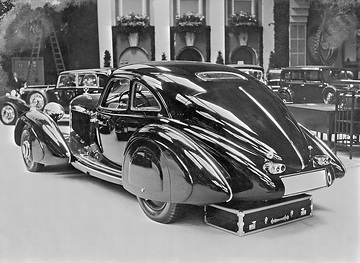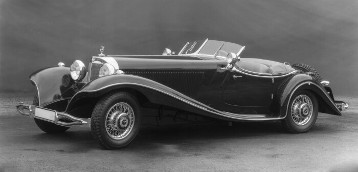1934
Download
Please wait a moment ...
Download
Please wait a moment ...
Delete
Do you really want to delete the data record?
Download
Please wait a moment ...
Download
Please wait a moment ...
Download
Please wait a moment ...
Crop for shopping cart
Please wait a moment ...
Set as main picture
Do you want to set this media object as main picture?
-
8 - 18 March 1934
-
Two new designs from Daimler-Benz make their debuts at the Berlin Motor Show: the 130 (W 23) is the first series-produced Mercedes-Benz passenger car with a rear-mounted engine and appears as the new entry-level model in the passenger car range; and the supercharged 500 model, also abbreviated to the 500 K (W 29) is fitted with a 5-litre eight-cylinder supercharged engine and replaces the 380 model. The new sports car model goes on display in Berlin as the so-called Autobahn-Kurierwagen (autobahn courier) designed "for particularly high speeds". The Nürburg 500 (W 08) is presented in slightly modified form under the new designation Mercedes-Benz 500 or 500 N.


-
May 1934
-
The start of production of the G 3a cross-country truck in Berlin-Marienfelde – it had been built in Untertürkheim since 1933 – marks the resumption of the series truck production there after a seven-year hiatus. In November the 12-tonne DB s 7 tractor also goes into production. Daimler-Benz builds this vehicle, equipped with a Maybach V12 engine, for the German military.

-
3 June 1934
-
The W 25 Grand Prix racing car – developed in accordance with the new 750-kg formula – ushers in the era of the Silver Arrows. Manfred von Brauchitsch drives the new car to victory in record time in its first competitive outing, the International Eifel Race at the Nürburgring. The Mercedes-Benz team also includes Rudolf Caracciola, Luigi Fagioli, Hanns Geier, Ernst Henne and racing manager Alfred Neubauer.


-
21/22 July 1934
-
In the "2,000 Kilometres Across Germany" endurance event, Mercedes-Benz drivers claim a total of 26 gold, three silver and three bronze medals in the individual and team rankings. The 1.5-litre Sports Saloon, the chassis of which forms the basis for the 150 Sports Roadster presented at the start of 1935, has its first competitive outing.








Loading












